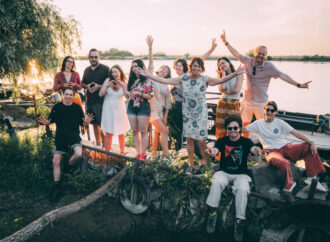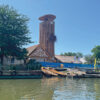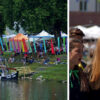Many people still think of Lake Balaton, the “Hungarian sea”, as a cheap package holiday- and party destination. However, the local town of Veszprém and its neighboring municipalities want to change the old image and establish the area as a new European cultural region. The title “European Capital of Culture” (ECOC) is awarded annually by
Many people still think of Lake Balaton, the “Hungarian sea”, as a cheap package holiday- and party destination. However, the local town of Veszprém and its neighboring municipalities want to change the old image and establish the area as a new European cultural region.
The title “European Capital of Culture” (ECOC) is awarded annually by the EU, since 2004 to at least two cities. Although there are still more Western European ECOCs overall, Central and Eastern Europe is catching up: since 2019, at least one city from the region has been included every year. In 2023, there are even two, Timisoara and Veszprém – and Veszprém did not apply alone, but together with 116 (!) municipalities from the Western Balaton region. This is why the project is called “Veszprém-Balaton 2023”, or “VEB2023” for short.
The localities of the region are participating because this offers an opportunity
for economic rebound and a new development perspective for them, said Márton Méhes, regional representative of VEB2023, to danube connects. “Culture is the source of renewal” and “culture creates region” is also stated in a VEB2023 pre-sentation. Moreover, tourism should not only focus on summer and the lakeshore, but also be extended to the back country, says Méhes. It is not for nothing that the motto of VEB2023 is “BEYOND”, because it is about disco-vering hidden treasures and showing the unknown behind the supposedly known – a concept that combines culture with tourism.
Alíz Markovits, chairperson of the VEB2023 organising company, pointed out that during the preparation of the application they had noticed that the ECOCs which included their surroundings were the most colorful, so they decided to make the same move. Moreover, this should have a positive effect on the whole area in the long run: “The ECOC program offers the possibility that Veszprém and the surrounding area as a new cultural creative region can function also in the long term as a important cultural-intellectual intellectual center, which with its diverse programs and and developments will help to raise the region to a European level of culture and creativity.
Veszprém’s mayor Gyula Porga said as early as November 2021 that the city was very proud of the title; however, holding it was not a goal, but an important means to ensure that Veszprém would be among the elite of Europe’s most livable cities within a few years. “By 2030, Veszprém would like to join the top 20 cities of the same size on the list of cultural and creative cities, in the company of cities like Weimar, Tartu, Avignon and Heidelberg,” says Porga.
Virtual worlds, digital mermaids and European container village
Already this year, numerous art and cultural programs are getting people in the mood for VEB2023, although the detailed program will not be published until October 2022. Until then it is still being worked on. However, at the beginning of April, Méhes gave a preview of the planned events at the Hungarian Cultural Institute in Stuttgart, including virtual worlds and exciting digital and multimedia projects, a festival of monsters and mermaids and the eco-art program called “Balatorium”.
It is also certain that in addition to VEB2023’s own productions, there will also be cooperation with organizers of existing events as well as with civil organizations and institutions through open calls for proposals.
The cultural year will begin on 21 January 2023, the Day of Hungarian Culture, with a colorful opening event; so that not only Veszprém and the Balaton region, but the whole country can present itself together, as Can Togay, artistic and creative director of VEB2023, explained. The program series also aims to make the region visible on a European level; fittingly, a two-week container village is being organized with 26 European cities.
Developments from the Vinyl Wine Bar to the Danube Swabian Pilgrimage Route
In addition, the dilapidated Heim Pál children’s hospital in Veszprém is being converted into a cultural center for young creative people as part of the ECOC, and will provide a rehearsal room for local music bands and dance groups. Alongside this, the Ruttner House, which belonged to a German-born merchant family in the 19th century, will be renovated and given new functions, a hostel, café and the prison museum visitor center. The castle garden is to be made available for creative activities and artists. The currently unused, almost 24,000 sqm “Gyárkert” (“Factory Garden”) area is to be converted into a cultural park. And the surrounding area is already benefiting from VEB2023: for example, the organizing company is supporting the renovation of the Roman museum complex Villa Romana Baláca in Balácapuszta with 500 million forints (approx. 1.31 million euros) and the development of modern exhibition and community spaces in Balatonfüred with 358 million forints (approx. 940,000 euros).
VEB2023 also plans to present itself at the International Danube Festival in Ulm/Neu-Ulm in July. Besides providing general information, a quiz with a prize competition is planned, Méhes revealed to danube connects. “Most people have already heard of Lake Balaton, which is a good basis for drawing attention to the ECOC,” he continued. They are also looking for new target groups for the local gastronomy and cultural sector: “In the 1990s and 2000s, Lake Balaton was considered a cheap holiday and party destination, but now the region is to be presented as a qualitative cultural experience and a new creative, diverse European region.”
According to the regional representative, a lot has happened in the gastronomy sector; besides Veszprém, the Balaton Uplands have also developed further, but without harming nature. Within the framework of the development program “Utcakép” (“Street Image”), new restaurants and bars have already opened in Veszprém where you can still eat something in the evening and there is always something going on: the cultural café “Papírkutya”, the modern design bistro Kunszt, which also functions as a gallery and community space, and the Wine & Vinyl Bar and Store, which is both a wine bar and a record shop.
Why is a visit to VEB2023 also worthwhile from a German perspective? As the organizers pointed out to danube connects, the heritage of the Danube Swabians who once lived here is commemorated with the help of a pilgrimage path below the adjacent Bakony Mountains. German artists are also taking part in the ECOC, such as the painter and performance artist Lilla von Puttkamer, who has already exhibited in Berlin, Düsseldorf, Budapest and Windhoek and who lives near Lake Balaton with her husband, a noble German wine grower.
Daniel Hirsch,
Budapest
Further information about VEB2023 on its official website



















